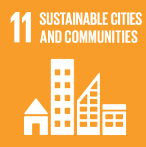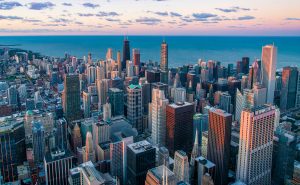SDG11 – Sustainable Cities and Communities

New Vocabulary
- inclusive
- community
- slum
- urban
- suburb
- sprawl
- settlement
- public transport
- sustainable city
Practice the new vocabulary
Sustainable Cities and Communities Vocabulary Practice (text version)
Match the words to their definitions
Words:
- public transport
- settlement
- community
- suburb
- sustainable city
- inclusive
- urban
- sprawl
- slum
Definitions:
- including every person
- people who live in the same area
- a neighbourhood that is in very bad condition with a lot of poor people
- a city area
- an area just outside a city where many neighbourhoods are
- spread out over a large area
- an area where a group of people come to live usually for the first time
- local buses, subways and trains which anyone can use
- a planned and managed city to help people protect the environment and support the economy.
Check your answer in footnote[1]
Activity source: Sustainable Cities and Communities Vocabulary practice by Virginia McHardy, CC BY-NC 4.0
Sustainable Cities and Communities
According to the United Nations Department of Economic and Social Affairs (n.d.) Goal 11 Infographic:
Goal 11 is about making cities safe, inclusive, and sustainable for everyone.
More than half of the world’s population lives in cities, and by 2050, this number will grow to 70%. However, many cities are not ready for this growth. Over 1.1 billion people live in slums or slum-like conditions, and this number could rise by 2 billion in the next 30 years.
Cities face many problems, like not enough housing, poor infrastructure, air pollution, and limited public spaces. Many small cities and towns are growing quickly, making inequality and urban poverty worse.
Cities also use a lot of energy and produce 75% of carbon emissions, even though they only cover 3% of the Earth’s land. They are also at high risk from climate change and natural disasters because so many people live close together.
To make cities better, they need safer housing, better public transport, and stronger plans to handle disasters and climate change. Without big changes, sustainable development will not be possible.
Canadian Perspective
Goal 11, Sustainable Cities and Communities (text version)
Make cities and human settlements inclusive, safe, resilient and sustainable
Core Housing Need in Canada
In 2021, 1 in 10 households lives in core housing[2] need. Among households in Canada, 20% lived in unaffordable housing, 5% lived in unsuitable housing, and 7% lived in inadequate housing. In Canada, 27% of respondents who have experienced homelessness lived in core housing need while 21% of women+[3] living alone lived in core housing need.
Community-Belonging
In 2021, 70% of Canadians reported a somewhat strong or very strong sense of belonging to their local community. Males aged 12-17 had the strongest sense of belonging at 85% while males aged 18-34 had the weakest sense of belonging at 63%.
Transit Passenger Trips
There were a total of 778 million passenger trips[4] in 2021. Total passenger trips were 59% lower than pre-pandemic levels.
Community Spotlight: Green Communities Canada
Green Communities Canada empowers community organizations to create new urban green space by tearing up unused pavement and planting trees. Since 2012, they have been active in 32 cities, converted 16,385 m2, and planted 334 trees and 11,543 perennial flowers.
Sources: Statistics Canada, Canadian Housing Survey, 2021. Statistics Canada, Monthly Passenger Bus and Urban Transit Survey, 2022. Statistics Canada, Canadian Community Health Survey – Annual Component, 2022. Green Communities Canada, 2022.
Source: Goal 11, Sustainable Cities and Communities In Agenda 2030 Sustainable Development Goals Report, 2022 by Statistics Canada, used under Open License
Discussion Questions
Use the new vocabulary words in these discussion questions. Ask and answer in partners or small groups:
- What does it mean for a city to be inclusive? How can we make sure everyone feels included in a city?
- What makes a community strong? What can people do to help their community become better?
- What is a slum, and why do people live in slums? How can we improve living conditions in slums?
- What is the difference between urban and rural areas? What are the benefits of living in an urban area?
- What are suburbs like compared to cities? Do you think suburbs
- are a good place to live? Why or why not?
- What is urban sprawl, and how does it affect a city? What can be done to stop
- urban sprawl?
- What is a settlement? How do
- settlements in cities differ from rural settlements?
- How important is public transport in a city? What are some ways to improve public transport systems?
- What does it mean for a city to be sustainable? Can you give examples of things that make a city sustainable?
- How do you think cities will change in the next 50 years? What are the biggest challenges cities will face in the future?
Watch the video:
Watch Goal 11: Sustainable Cities and Communities (1 min) on YouTube
Video source: UNStats. (2022, July 7). Goal 11 – Sustainable cities and communities [Video]. YouTube. https://www.youtube.com/watch?v=gh0lRJ1F9Fk
Sustainable Cities video Quiz (text versions)
- True or false? One of the fastest growing megacities inhabits migrants into their poorest areas.
- How many people live in slums around the world?
- 1,000,000
- 1,000,000,000
- 100,000
- True or false? If you live in a city, you will most likely be breathing in polluted air.
- Use the numbers provided to complete the sentence:
Numbers: 55%, 85%
Sentence: Out of the [Blank A] of collected solid waste, only [Blank B] of it is handled in controlled facilities. - True or false? Most people in sub-Saharan Africa can use buses and trains.
Check your answers in footnote[5]
Activity source: Sustainable Cities and Communities Video quiz by Virginia McHardy, CC BY-NC 4.0
Key Targets for SDG 11
- 11.1 By 2030, ensure access for all to adequate, safe and affordable housing and basic services and upgrade slums.
- 11.2 By 2030, provide access to safe, affordable, accessible and sustainable transport systems for all, improving road safety, notably by expanding public transport, with special attention to the needs of those in vulnerable situations, women, children, persons with disabilities and older persons.
- 11.3 By 2030, enhance inclusive and sustainable urbanization and capacity for participatory, integrated and sustainable human settlement planning and management in all countries.
- 11.4 Strengthen efforts to protect and safeguard the world’s cultural and natural heritage.
- 11.5 By 2030, significantly reduce the number of deaths and the number of people affected and substantially decrease the direct economic losses relative to global gross domestic product caused by disasters, including water-related disasters, with a focus on protecting the poor and people in vulnerable situations.
- 11.6 By 2030, reduce the adverse per capita environmental impact of cities, including by paying special attention to air quality and municipal and other waste management.
- 11.7 By 2030, provide universal access to safe, inclusive and accessible, green and public spaces, in particular for women and children, older persons and persons with disabilities.
- 11.a Support positive economic, social and environmental links between urban, peri-urban and rural areas by strengthening national and regional development planning.
- 11.b By 2020, substantially increase the number of cities and human settlements adopting and implementing integrated policies and plans towards inclusion, resource efficiency, mitigation and adaptation to climate change, resilience to disasters, and develop and implement, in line with the Sendai Framework for Disaster Risk Reduction 2015-2030, holistic disaster risk management at all levels.
- 11.c Support least developed countries, including through financial and technical assistance, in building sustainable and resilient buildings utilizing local materials.
Source: United Nations Department of Economic and Social Affairs. (n.d.). Goal 11 [Infographic]. Sustainable Development Goals. https://sdgs.un.org/goals/goal11
Homework/Assignments:

City Design:
- Imagine you are building a new city. Design your city on paper or using a computer program (such as drawing tools or a PowerPoint presentation).
- Make sure your city includes the following:
- Green spaces (parks, trees, gardens)
- Public transport (buses, trains, bike lanes)
- Affordable housing (good homes for everyone)
- Energy efficiency (using renewable energy like solar or wind power)
- Waste management (how to recycle and reduce trash)
You can read more about Goal #11 in The Sustainable Development Goals Report 2022 from the UN.:
For instructors, please visit York University’s The SDGs-in-the-Classroom Toolkit for lesson ideas
Attribution & References
Except where otherwise noted, this page is created by Virginia McHardy, CC BY-NC 4.0
References
United Nations Department of Economic and Social Affairs. (n.d.). Goal 11 [Infographic]. Sustainable Development Goals. https://sdgs.un.org/goals/goal11
- 1. inclusive, 2. community, 3. slum, 4. urban, 5. suburb, 6. sprawl, 7. settlement, 8. public transport, 9. sustainable city ↵
- Core housing need refers to whether a private household’s housing falls below at least one of the indicator thresholds for housing adequacy, affordability or suitability, and would have to spend 30% or more of its total before-tax income to pay the median rent of alternative local housing that is acceptable (attains all three housing indicator thresholds). Housing data for 2021 includes the 10 provinces only. ↵
- “Women+” includes women and girls, as well as some non-binary persons. ↵
- Passenger trips refer to trips from a point of origin to a destination by persons who are travelling on a public (passenger bus and urban transit system) or private conveyance, other than the driver, pilot or crew. ↵
- 1. True, 2. b, 3. True, 4. Blank a - 85%, Blank b - 55%, 5. False. ↵
including every person
a neighbourhood that is in very bad condition with a lot of poor people
a city area
people who live in the same area
an area just outside a city where many neighbourhoods are
spread out over a large area
an area where a group of people come to live usually for the first time
local buses, subways and trains which anyone can use
a planned and managed city to help people protect the environment and support the economy

